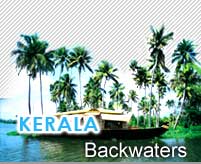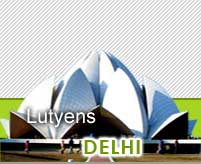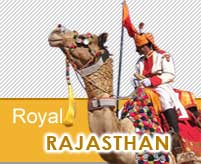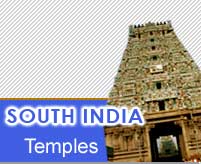
- Enchanting Kerala
- Starting at $510.00*
- Classical India with Nepal
- Starting at $820.00*
- Heritage Rajasthan Tour
- Starting at $775.00*
- Rapid Golden Triangle
- Starting at $240.00*
- Palace on Wheels
- Starting at $500.00*
- Exotic Kerala Tour
- Starting at $610.00*
- More Tours...
Incredible South India
Duration: 20 nights - 21 days
Locations: Chennai - Mahabalipuram –Tanjavur – Trichy – Madurai - Periyar- Kovalam – Thottapalli – Alleppey - Cochin – Mysore – Hassan – Hospet – Bangalore – Bombay
| Tour Highlights | |
| Chennai | Fort St. George, San Thome Cathedral & the Museum |
| Mahabalipuram | Shore Temple, Arjuna's Penance & Five Rathas |
| Kanchipuram | Temple |
| Tanjavur | Brihadeshwara temple |
| Trichy | Srirangam Temple & Rockfort |
| Trichy | Srirangam Temple & Rockfort |
| Madurai | Meenakshi Sundareshwar |
| Periyar | Wildlife Sanctuary, Boat Cruise Optional Spice plantation tour |
| Kovalam | Beaches |
| Thotapalli, Alleppey | Backwaters |
| Cochin | Kathakali, St. Francis Church, Dutch Palace (Built by Portuguese), Jew Town, Jewish Synagogue, spice market & Chinese fishing nets Optional Boat Cruise |
| Mysore | Srirangapatnam & Tipu's Summer Palace, Maharaja's Palace & Chamundi Hill |
| Hassan | Chennakeshawa Temple in Belur & Hoyasaleshwara Temple in Helebid |
| Hampi | Vitthal Temple, Queen's Bath & Lotus Mahal |
| Bangalore | Tipu Sultan Palace & Museum, ISKCON Temple & Lal Bagh Garden. |
Detailed Itinerary
Day 01 - Arrive Chennai
Arrive Chennai, after a traditional 'Swagat' (Welcome) our representative would assist you at the airport & to our hotel for check in. Chennai (formerly known as Madras), is known for its cultural heritage & temple architecture. The region was served as an important administrative, military, & economic centre dating back to the 1st century. The first Westerners were Portuguese, who arrived in the year 1522 & built a port. It then passed on to the Dutch in 1612. In 1639 the British East India Company established a fort & trading post & since then this coastal centre of trade has drawn traffic from all over the world.
Overnight Hotel – Chennai (B)
Day 02 - Chennai – Mahabalipuram (70 km - 02 hr)
Full day tour
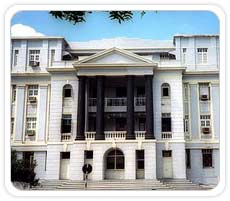 Today we take a tour of Chennai, visiting Fort St. George, the first bastion of British power in India & built in the year 1640 AD by the British East India Company. Within the Fort we visit St. Mary's Church, built in the year 1680 & oldest Protestant Church in the East. Fort Museum has 10 galleries & displays armoury, old uniforms, crockery & silverware, coins, palanquins, paintings, letters, old prints, etc. San Thome Cathedral, built in 1504, is said to house the remains of St. Thomas the Apostle, who is believed to have visited Madras (Chennai) sometime during 52 AD.
Today we take a tour of Chennai, visiting Fort St. George, the first bastion of British power in India & built in the year 1640 AD by the British East India Company. Within the Fort we visit St. Mary's Church, built in the year 1680 & oldest Protestant Church in the East. Fort Museum has 10 galleries & displays armoury, old uniforms, crockery & silverware, coins, palanquins, paintings, letters, old prints, etc. San Thome Cathedral, built in 1504, is said to house the remains of St. Thomas the Apostle, who is believed to have visited Madras (Chennai) sometime during 52 AD.
National Art Gallery, established in the year 1857, is undoubtedly one of the country's finest museums. It has sections devoted to geology, archaeology, anthropology, botany, zoology, sculpture & numismatics. Government Museum has a fine archaeological section representing all the major South Indian periods including Chola, Vijaynagar, Hoysala & Chaulakya. The bronze gallery has a superb collection of Chola art especially the bronze statue of Ardhanareeswara, the androgynous incarnation of Shiva. Its most prized possessions are the relics from 2nd century AD Buddhist site of Amaravathi & the prehistoric antiques of South India.
Later we drive to Mahabalipuram, town of temples, sand & sea. It is world renowned for its beautiful Shore Temple & other temples. It was once the main port & naval base of the great Pallava kingdom & was later made the capital of this dynasty. Most of the temples here are dedicated to Lord Shiva & Vishnu. These structures were built by three successive Pallava Kings, between 630 A.D & 728 A.D, who developed the Dravidian style of temple architecture within the short span of a hundred years. The monuments are mostly rock-cut & monolithic, constitute the early stages of Dravidian architecture, wherein Buddhist elements of design are prominently visible. It is known especially for its rathas (temples in form of chariots), mandapas (cave sanctuaries) & giant open-air bas-reliefs & has been classified as UNESCO World Heritage Site.
Overnight Hotel – Mahabalipuram (B)
Day 03 - Mahabalipuram - Excursion to Kanchipuram (70 km - 02 hr)
Today, we take a guided tour of Mahabalipuram, visiting Shore Temple, one of the oldest temples in South India. It belongs to the 7th Century AD & is a good example of the first phase of the structure of temples constructed in the Dravidian style. Designed to catch the first rays of the rising sun & to illuminate the waters after dark, the temple ended up with an unusual lay-out.
Arjuna's Penance is the world's largest bas-relief. This huge whale-back shaped rock contains figures of gods, demigods, men, 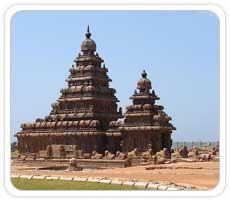 beasts, birds. Next we visit Rathas, monolithic temples fashioned as chariots. They remain an architectural mystery, for each is apparently a faithful reproduction of a structure built of wood. In fact, even the grain of the timber beams & rafters has been simulated in stone. Of the eight Rathas, five have been named for the Pandava brothers, the heroes of the epic Mahabharata.
beasts, birds. Next we visit Rathas, monolithic temples fashioned as chariots. They remain an architectural mystery, for each is apparently a faithful reproduction of a structure built of wood. In fact, even the grain of the timber beams & rafters has been simulated in stone. Of the eight Rathas, five have been named for the Pandava brothers, the heroes of the epic Mahabharata.
Later we take a day excursion to Kanchipuram, is one of the seven holy cities in the country. It was a city of learning for both Tamil & Sanskrit, & was believed to be visited by Hsuan Tsang. In ancient times it was called Kachi. Once had over a thousand temples & today there are more than a hundred extant. It is also known for its temples & silk sarees. We visit Kailasanatha Temple, built in 8th Century AD. It is built in the typical Pallava style, with a pyramidal tower, a pillared hall & vestibule, enclosed by a wall. The temple is famous for exquisite carvings & attracts devotees & tourists alike. There are 58 small shrines situated around the main shrine, as a compound wall. Fresco style paintings adorn the inner walls of the temple. Next we visit Ekambaranatha, ancient temple is dedicated to lord Shiva. The 57 metres high Raj Gopuram is one of the tallest towers in South India. The 3000 year old mango tree inside the temple has 4 branches each yielding different variety of mangoes.
Before returning to Mahabalipuram we visit Kamakshi Amman Temple, built in 12th century AD, as an important Shakthisthalam, known as Parabrahmaroonpini. The main deity is seated on Brahma, Vishnu, Rudra, Eswara & Sadasiva.
Overnight Hotel – Mahabalipuram (B)
Day 04- Mahabalipuram - Tanjore (300 km - 06 hr)
Today we drive to Tanjore, flourished during the rule of the Nayaks & Mahrattas. It has been the treasure house of art for centuries. It is called the Rice Bowl of Tamil Nadu. Thanjavur is well-known throughout the world for its exquisite handicrafts like the Art Plate, pithwork, bronze icons, Thanjavur paintings & the classical South Indian musical instruments.
Later we visit Brihadeshwara temple, also known as Big Temple, built by Rajaraja Chola I was completed around 1010 CE. This 10th century CE temple, one of UNESCO World Heritage Sites, is a brilliant example of the Dravidian style of temple architecture. The beautiful Chola Fresco paintings on the inner walls of the temple are no way less than Ajanta paintings.
Overnight Hotel – Tanjore (B)
Day 05 - Tanjore - Madurai via Trichy(200 km - 04 hr)
Today we leave for Madurai, rich cultural heritage passed for more than 2500 years old & has been an important commercial centre as early as 550 AD. It is the oldest city in Tamil Nadu & was originally known as Kadambavanam or the forest of Kadamba.
En route Trichy
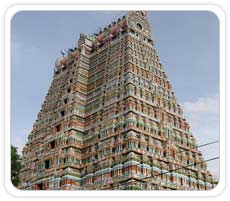 En route we stop at Trichy, which has very historic temples, monuments & churches. It was an important town in the days of the later Cholas, Nayaks as well as during the early days of the British East India Company. We start with Srirangam Temple, surrounded by the waters of the River Kaveri on one side & its tributary Kollidam on the other, is a 600-acre island-town enclosed within the seven walls of the gigantic Sri Ranganathaswamy Temple. There are not less than 21 Gopuram here in this temple, one of which is the tallest in South India.
En route we stop at Trichy, which has very historic temples, monuments & churches. It was an important town in the days of the later Cholas, Nayaks as well as during the early days of the British East India Company. We start with Srirangam Temple, surrounded by the waters of the River Kaveri on one side & its tributary Kollidam on the other, is a 600-acre island-town enclosed within the seven walls of the gigantic Sri Ranganathaswamy Temple. There are not less than 21 Gopuram here in this temple, one of which is the tallest in South India.
Later we visit Rockfort most famed landmark is an 83 m high rock which is the only outcrop in the otherwise flat land of the city. The most amazing fact about the rock is that it is one of the oldest in the world approximately 3,800 million years, which makes it as old as the rocks of Greenland & older than the Himalayas.
Overnight Hotel – Madurai (B)
Day 06 - Madurai
Half Day Tour
Morning visit to Meenakshi Sundareshwar, was first built 2000 years ago & was substantially expanded between the years (1623-55 AD). Initially there was only the Shiva temple. A striking feature of the temple is the astonishing structure known as Ayiramkaal mandapam or the Hall of a thousand pillars in the outermost corridor.
Overnight Hotel – Madurai (B)
Day 07 - Madurai - Periyar (136 km - 03 ½ hr)
Today we drive to Periyar, Set on an attractive lakeside, it is South India's most popular Wildlife Sanctuary. It is a place to cruise on the lake & gives an opportunity to see wildlife. It is home to tigers, leopards, elephants, bison, antelopes, sambhar, wild boar, monkey, a wide variety of birds.
Option Tour – Spice Plantation
Overnight Hotel – Periyar (B)
Day 08 - Periyar – Kovalam (250 kms/06 hours)
At sun rise we take a boat ride to view wildlife in the sanctuary on Lake Periyar. After two hours of wildlife viewing we get back to the hotel for breakfast.
Later we drive to Kovalam, South of Trivandrum. There are two main beaches at Kovalam, separated by a high cliff. It is finding a new significance in the light of several Ayurvedic salons, & recuperation & regeneration resorts which provide a slew of Ayurvedic.
Overnight Hotel – Kovalam (B)
Day 09 - Kovalam
Day at leisure
Day 10 - Kovalam Excursion to Trivandrum & Kanyakumari
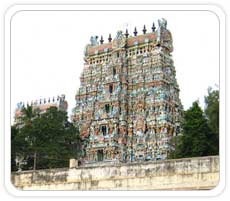 Today we take an excursion Trivandrum (Thiruvananthapuram), an ancient city with trading traditions dating back to 1000 BC. It was a trading post for spices like the rest of ancient Kerala. However the ancient political & cultural history of the city was almost entirely independent from that of the rest of Kerala. The early rulers of the city were the Ays. With their fall in the 10th century, the city was taken over by the rulers of Venad. Thiru-v-anantha-puram is a three syllable name meaning the abode of the sacred snake god "Anantha". Lord Vishnu of the ancient Indian mythology rests on this huge serpent.
Today we take an excursion Trivandrum (Thiruvananthapuram), an ancient city with trading traditions dating back to 1000 BC. It was a trading post for spices like the rest of ancient Kerala. However the ancient political & cultural history of the city was almost entirely independent from that of the rest of Kerala. The early rulers of the city were the Ays. With their fall in the 10th century, the city was taken over by the rulers of Venad. Thiru-v-anantha-puram is a three syllable name meaning the abode of the sacred snake god "Anantha". Lord Vishnu of the ancient Indian mythology rests on this huge serpent.
Here we visit the Padmanabha Swami Temple, dedicated to Lord Vishnu is held sacred by the Hindus from antiquity. The temple has a large complex with a huge Gopuram. It has a tank beside it for ritual bathing. Next we visit It is situated north of the city, at Museum road & 400m east of Indian airlines. It displays an eclectic assortment of historical & contemporary ornaments, temple carts, ivory carvings & life-size figures of Kathakali dances in full costume. It has a famous collection of 8th-18th century south Indian bronze. Sri Chittira Art Gallery, an excellent collection of Indian art with examples from early to modern schools. Paintings by Raja Ravi Varma & works from Mughal & Rajput miniature paintings & Tanjore paintings embellished with semi- precious stones are displayed.
Then we visit Kanyakumari, situated at the shore on the confluence of the Bay of Bengal, Indian Ocean & the Arabian Sea. got its name from the Kumari Amman or the Kanyakumari Temple According to the local lore, Kanya Devi, an avatar of Parvati, was to marry Shiva, but he failed to show up to the wedding. The rice & other grains meant for the wedding feast remained uncooked. Today tourists can buy tiny stones which look like rice, in remembrance of the marriage that was never solemnized.
Next we visit Kanyakumari Temple: The temple overlooks the shoreline. It is dedicated to Parvati as Devi Kanya, the Virgin Goddess who did penance to obtain the hand of Lord Shiva. The deity, Devi Kanyakumari is' the protector of India's shores' has an exceptionally brilliant diamond on her nose ring which is supposed to shine out to sea. Also visit Vivekananda Memorial, about 500 meters away from mainland. This memorial stands on one of two rocks separated by about 70 meters. It was built in the year 1970, memorial is dedicated to Swami Vivekananda, the greatest social reformer. He was supposed to have medicated on the rock where the memorial stands today. A meditation hall is also attached with the memorial. It houses a statue of Vivekananda. The divine foot print 'Pada Parai' of Devi is also seen here. Ferry service is available to reach the memorial.
Overnight Hotel – Kovalam (B)
Day 11 - Kovalam – Thottapalli (90 km - 02 hr)
we board the houseboat, locally called Kettuvallam, cruise around beautiful backwaters of Thothapalli to Alleppey to observe & experience the daily life of the villagers along the backwaters.
Overnight Houseboat (B, L, D)
Day 12 - Alleppey – Cochin (60 kms/01 hour)
Today we disembark the boat at Alleppey.
Later drive to Cochin always had a very popular & historical sea trade connection with Middle East, Mediterranean Europe & Dutch. It has one of the finest natural harbours on the Arabian coastline. Its cosmopolitan character is reflected in the buildings & structures representing different regions of the world.
Overnight hotel – Cochin (B)
Day 13 - Cochin
Full Day Tour
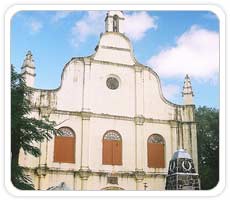 Today we take a tour of Cochin, visiting St. Francis' Church, built in the year 1503 by Portuguese Francisan Friars & known to be the oldest European church in India. It was restored in the year 1779 by the protestant Dutch, converted to an Anglican Church by the British in 1795. Vasco da Gama's remains were buried here in 1524 & later moved to Lisbon, Portugal. We also visit Dutch Palace, originally built by the Portuguese. Later in 17th century they modified it & presented it to the Raja (King) of Kochi (Cochin). The Palace has a fine collection of mural paintings depicting scenes from Hindu epics, Mahabharata & Ramayana.
Today we take a tour of Cochin, visiting St. Francis' Church, built in the year 1503 by Portuguese Francisan Friars & known to be the oldest European church in India. It was restored in the year 1779 by the protestant Dutch, converted to an Anglican Church by the British in 1795. Vasco da Gama's remains were buried here in 1524 & later moved to Lisbon, Portugal. We also visit Dutch Palace, originally built by the Portuguese. Later in 17th century they modified it & presented it to the Raja (King) of Kochi (Cochin). The Palace has a fine collection of mural paintings depicting scenes from Hindu epics, Mahabharata & Ramayana.
Later we visit Jew Town, synagogue, built in the year 1568, is magnificently decorated by Chinese tiles & Belgian chandeliers. Giant scrolls of the Old Testament can be found here. Also visit the spice market, where the air is filled with the pungent smell of spices & history that brought the world to its doorstep. Chinese fishing nets, (Cheenavala) are distinctly unique to Cochin. It is believed that traders from the court of the Chinese ruler Kublai Khan introduced these nets here.
Later we attend Kerala's most popular classical dance performance, Kathakali by local artist.
Overnight Hotel – Cochin (B)
Day 14 - Cochin – Guruvayur - Mysore (250 km – 5 hr)
Early morning drive to Mysore visiting Guruvayur enroute. On arrival transfer to hotel
Overnight hotel - Mysore (B)
Day 15 - Mysore
We take a full day City Tour of Mysore with visiting Srirangapatnam & Tipu's Summer Palace, the Maharaja's Palace & Chamundi Hill, which is topped with a temple of Durga with the magnificent 5m tall Nandi, carved from a single piece of granite in year 1659, one of the largest in India.
Overnight Hotel – Mysore (B)
Day 16 - Mysore – Hassan (150 km - 03 hr)
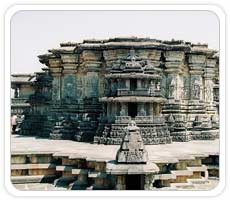 Today we drive to Hassan, founded in the 11th century, by Channa Krishnappa Naik, a Palegar. The place is called Hassan after the Goddess Hasanamba (the smiling Goddess) presiding deity of the town.
Today we drive to Hassan, founded in the 11th century, by Channa Krishnappa Naik, a Palegar. The place is called Hassan after the Goddess Hasanamba (the smiling Goddess) presiding deity of the town.
Half Day tour
Later we take a tour of Chennakeshawa Temple at Belur, built in the year 1117 AD to celebrate Hoysala military victories & it took over a hundred years to complete. Stories from the Purans, Upanishads & other mythological sources have been executed in the most exquisite & authentic detail, tales from Ramayana & Mahabharata. We also visit the Hoyasaleshwara Temple at Helebid, built by Kettuvallam, during 1121 AD. Dedicated to Lord Siva has two shrines connected by pillared walls & in each shrine is a Lingam Hoyasaleshwara & Shanthaleshwara.
Overnight Hotel – Hassan (B)
Day 17 - Hassan - Hospet (150km – 03 hr)
Today we drive to Hospet, once a beautiful capital city of Vijaynagar empire, in ancient days was known as Nagalapura. The city was razed to the ground by Sultan of South India in the year 1565
Overnight Hotel – Hospet (B)
Day 18 - Hospet
Excursion Hampi
Today we take a day excursion to Hampli, the capital city of the Vijaynagar Empire. Founded by Harihara & Bukka in 1336, it fell to the Muslim rulers in 1565 after the disastrous Battle of Talikota, subsequently lapsed into decline & abandonment. The once proud city of victory is now a city of desolation.
We visit the ruins of the Virupaksha Temple, dedicated to Lord Shiva & Pampadevi. This is the only temple that is still used for worship. The temple, with its nine-storied Gopuram & ceiling of the ranga mantapa is beautifully painted with scenes from the epics & Puranas. Later visit Vittala, a splendid 56 musical pillars complex. To the east of the hall is the famous Stone Chariot with stone wheels that actually revolve. Several of the carved pillars were attacked & a large portion of the central part has been destroyed.
We also visit Elephant stables, a beautiful example of Hindu-Muslim style of architecture, housed about 11 elephants in separate compartments. Queen's bath, structure has a very plain exterior but interior is stunningly ornate, with graceful arched corridors, projecting balconies. Lotus Mahal, lotus flower top, this two-story structure has beautiful arc ways set in geometric regularity. It was an air-cooled summer palace of the queen.
Overnight Hotel – Hospet (B)
Day 19 - Hospet – Bangalore (290 km/07 hours)
Early morning drive to Bangalore, the garden city. The spacious city has many imposing structures full of historic & modern architecture. The majestic Vidhana Soudha, a magnificent post-independence structure housing the State legislature & Secretariat, stands in the center of the city with its attractive dome & galleries
Overnight Hotel – Bangalore (B)
Day 20 - Bangalore – Bombay (by flight)
Half Day Tour
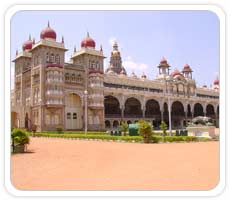 Today we take a guided tour of Bangalore, visiting Tipu Sultan Palace; the layout of the palace gives the idea of the ethnic Mughal lifestyle. The fort & its remains present the history of the era in which it was built. The construction of the Tipu palace was started by Haider Ali & completed by Tipu Sultan, it is now a museum. Also visit ISKCON Temple, harmonious blend of the Dravidian & modern architecture. The building has some of the modern facilities along with Vedic preaching library.
Today we take a guided tour of Bangalore, visiting Tipu Sultan Palace; the layout of the palace gives the idea of the ethnic Mughal lifestyle. The fort & its remains present the history of the era in which it was built. The construction of the Tipu palace was started by Haider Ali & completed by Tipu Sultan, it is now a museum. Also visit ISKCON Temple, harmonious blend of the Dravidian & modern architecture. The building has some of the modern facilities along with Vedic preaching library.
Next we visit the Lal Bagh Garden, name Lal Bagh has been given to it for the wonderfully bloomed red roses that remain blooming all through the year. Haider Ali started building this garden in 1760
Later we drive to airport to baord flight for Bombay. We arrive Bombay transfer to the international airport to board flight for onward journey.
Day 21 - Bombay departure
Our tour concludes: Caper thanks you for your patronage & look forward serve you again in near future.
Package includes:
- 20 Nights accommodation on twin sharing basis with short stay in Mumbai.
- Buffet breakfast
- A-C transportation as per the itinerary (No transportation on leisure days).
- Local English speaking guide as per the itinerary.
Package does not include:
- Any airfare or airport tax.
- All presently applicable taxes.
- Any Monument entry fee & camera fee.
- Optional Tours
- Any expense of personal nature such as hard-soft drinks, laundry, phone-fax calls, tips etc.
Any other expense not mentioned in the "Package includes".
 |
||
NORTH EAST INDIA TOURS
SOUTH INDIA TOURS CENTRAL INDIA TOURS |
NORTH INDIA TOURS
WEST INDIA TOURS |
|
Copyright © 2020, www.CaperIndiaTours.com
Recognized by Ministry of Tourism, Government of India
National Tourism Award Winner

Powered by SOFTTIX
General Terms and Conditions* - Estimated per person tour cost for minimum 2 pax travelling together using 3 star hotel on twin sharing basis.
